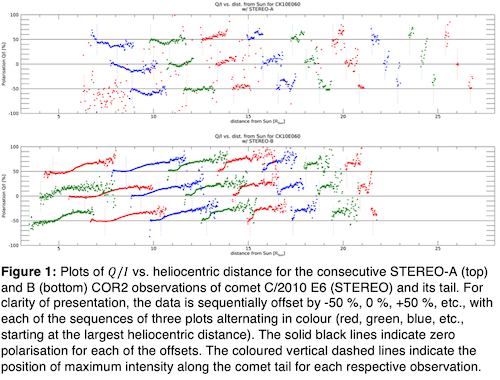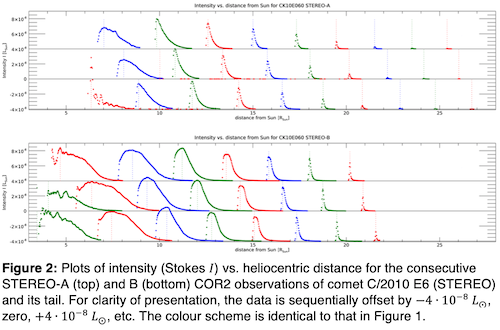Effects of heliocentric distance on polarisation of comet C/2010 E6 (STEREO)
- 1Armagh Observatory & Planetarium, Armagh, United Kingdom of Great Britain and Northern Ireland (rok.nezic@armagh.ac.uk)
- 2Mullard Space Science Laboratory, University College London, United Kingdom of Great Britain and Northern Ireland
- 3The Centre for Planetary Sciences, UCL/Birkbeck, United Kingdom of Great Britain and Northern Ireland
Abstract
We present detailed polarimetric analysis of pre-perihelion STEREO observations of Kreutz group comet C/2010 E6 (STEREO), focusing on the changes in polarisation with decreasing heliocentric distance in the pre-perihelion STEREO spacecraft hourly observations of the comet in March 2010. We utilise a bespoke image analysis method for the coronagraph data, finding the Stokes parameters for comet and its tail. The results show a clear variability in polarisation, which can be attributed to sublimation of refractory material.
1. Introduction
Polarimetry is a useful tool for remote observations of comet refractory material, since it can provide constraints on its structure and composition. Near-Sun comets like C/2010 E6 (STEREO) are interesting partly for their frequency – Kreutz group comets represent the single largest comet family [1] – but mostly for the intense near-Sun environment they experience. The comet’s approach to perihelion is likely accompanied by sublimation of refractory material, therefore we can, by studying comet's changing polarimetric signature during its approach to the Sun, extract information about the composition of refractory material in cometary dust. The full analysis is presented in [2].
2. Observations
Comet C/2010 E6 (STEREO) belongs to the Kreutz family of sungrazing comets, which share very similar orbital parameters and are thought to be the remnants of a larger parent comet [1,3,4].
The comet was imaged by the twin STEREO (Solar Terrestrial Relations Observatory) spacecraft in March 2010; A (Ahead) and B (Behind). In this work only COR2 visible light (bandpass 650-750 nm) coronagraph imagery is used [5].
Permanently in the light path of COR2 is a linear polariser which can be set at three angles: 0º, 120º, and 240º relative to a reference position. A sequence (triplet) of images using the three different polariser angles in quick succession is taken once per hour.
3. Methodology
The image analysis was conducted using a bespoke semi-automated routine fine-tuned for the use with STEREO COR2 data.
Firstly, the image triplets undergo standard pre-processing using the SECCHI_PREP routine from the SolarSoft library for IDL [6]. Then the comet head is found interactively in the image triplets.
Orbital parameters are used to find the plane of the comet's orbit, in which the dust tail is assumed to lie; all data points in the images are then mapped onto this plane. From this, the phase angle - between the Sun, the comet, and the spacecraft – can be determined.
Comet tail is then traced in each separate image. Its transverse cross-sections first have their background removed using a cubic fit and are then truncated (integrated) to a single point for each longitudinal step.
The three resulting polarised intensity vectors from the image triplet are then aligned, and the polarimetric properties (Stokes parameters Q, U, and I) calculated. The method is similar to, but distinct from, the one used by [7,8].
4. Results
We present two sets of plots of STEREO/SECCHI/COR2 observations of comet C/2010 E6 (STEREO): polarimetric (Figure 1) and photometric (Figure 2). All data is plotted against heliocentric distance. Since the data would contain considerable overlap otherwise, three different offsets are used to stagger the data.
The phase angle information is lost in these plots. STEREO-A phase angle observations range between ~35º and ~25º (right to left). The phase angle range in STEREO-B observations is ~135º to ~105º (right to left). The phase angle variation along the tail is small for each observation.


5. Discussion & Conclusions
Prior to perihelion, at which it likely disintegrated, comet C/2010 E6 (STEREO) exhibited a variety of peculiar behaviours - both photometric and polarimetric - which distinguish it from most other comet observations [9].
Most notable is the sudden drop in polarisation of the comet nucleus at ~20 R⨀, which then spread slowly along the comet tail. This is accompanied later (~15 R⨀) by a broadening of the intensity peak from the nucleus further down the tail. The broadening and brightening are consistent with those observed by e.g. [4].
The polarimetric signature of near-zero (STEREO-B, high phase angles) or negative (STEREO-A, low phase angles) polarisation spreading from the near-nucleus region along the tail is consistent with sublimation of silicate particles at local temperatures exceeding their sublimation point. This effect propagates slowly both through the ablating surface and through the dust tail, as sublimation acts as a source of cooling. Thus the observed negative polarisation at low phase angle may explained as the response of the as of yet unsublimated fluffy dust particles of primarily silicate composition.
Acknowledgements
We would like to thank M. Knight, K. Battams, and V. Andretta for their help and collaboration. This research is supported through the UK Science and Technology Facilities Council and has made use of data and/or services provided by the IAU’s Minor Planet Center.
References
[1] Battams, K. and Knight, M. M.: SOHO comets: 20 years and 3000 objects later, Phil. Trans. R. Soc. A, Vol. 375: 20160257, 2017
[2] Nežič, R. et al.: Polarimetric analysis of pre-perihelion STEREO observations of Kreutz group comet C/2010 E6 (STEREO), 2020, in prep.
[3] Jones, G. H. et al.: The Science of Sungrazers, Sunskirters, and Other Near-Sun Comets, Space Sci Rev, Vol. 214: 20, 2018
[4] Knight, M. M. et al.: Photometric Study of the Kreutz Comets Observed by SOHO from 1996 to 2005, AJ, Vol. 139: 3, pp. 926-949, 2010
[5] Howard, R. A., Moses J. D., and Socker D. G.: Sun Earth Connection Coronal and Heliospheric Investigation (SECCHI), Proceedings of SPIE, Vol. 4139-26, 2000
[6] Freeland, S. L. and Handy, B. N.: Data Analysis with the SolarSoft System, Solar Physics, Vol. 182, pp. 497-500, 1998
[7] Thompson, W. T.: Linear polarization measurements of Comet C/2011 W3 (Lovejoy) from STEREO, Icarus, Vol. 261, pp. 122-132, 2015
[8] Thompson, W. T.: Changing linear polarization properties in the dust tail of comet C/2012 S1 (ISON), Icarus, Vol. 338, pp. 113533, 2020
[9] Kiselev, N. et al.: Comets, Chapter 22 in Polarimetry of Stars and Planetary Systems (ed.: Kolokolova, L. et al.), CUP, pp. 379-404, 2015
How to cite: Nezic, R., Bagnulo, S., and Jones, G.: Effects of heliocentric distance on polarisation of comet C/2010 E6 (STEREO), Europlanet Science Congress 2020, online, 21 September–9 Oct 2020, EPSC2020-817, https://doi.org/10.5194/epsc2020-817, 2020

